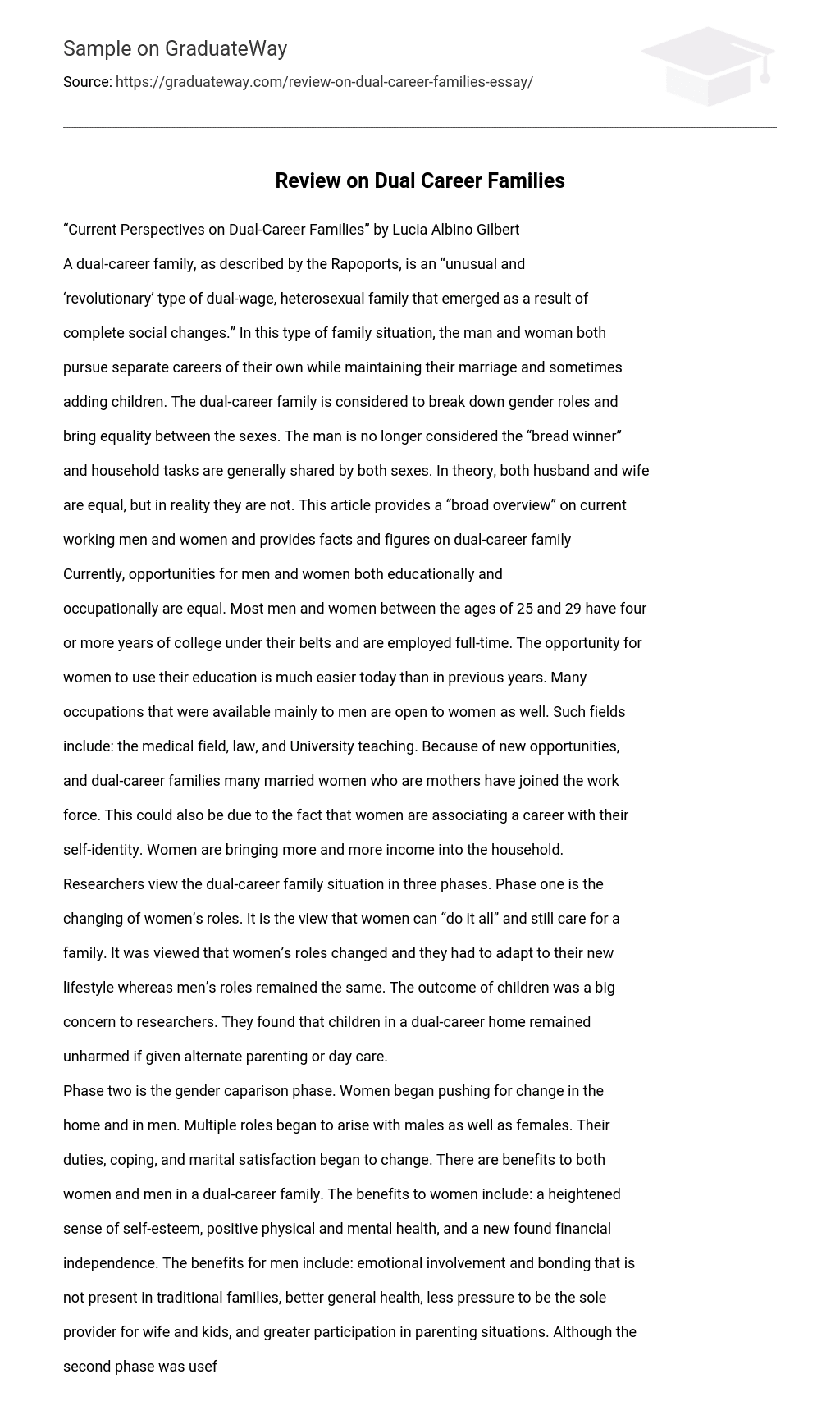A dual-career family is a non-traditional and groundbreaking heterosexual family that has arisen as a result of significant societal changes. Within this setup, both the husband and wife focus on their individual careers while being married and potentially having children. This particular type of family defies traditional gender norms and advocates for gender equality.
The traditional notion of men as primary earners in households is outdated, as both men and women now commonly share household responsibilities. Nevertheless, this equality does not always manifest in real-life scenarios. This article extensively examines the present situation of employed men and women, particularly focusing on couples where both partners have careers. At present, educational and professional prospects are equally accessible to both genders. A majority of individuals aged 25 to 29 have completed at least four years of college education and work full-time.
Compared to earlier times, women now have greater opportunities to utilize their education. Professions that were previously dominated by men, such as medicine, law, and university teaching, are now open to women as well. The rise of dual-income households and the emergence of new job prospects have motivated married mothers to join the workforce. This shift can be attributed to women recognizing the importance of their careers in shaping their self-identity.
Researchers have identified three stages in the development of dual-career families that illustrate women’s increasing contribution to household income. The initial stage focuses on the shifting roles of women as they strive to balance career and family responsibilities, highlighting the belief that women can handle multiple roles while still caring for their families. During this stage, women had to adapt to their new lifestyle while men’s roles remained unchanged. Researchers were particularly concerned about the impact on children but found that if provided with alternative parenting or day care, children in dual-career households did not experience negative effects.
The second stage involves a comparison of gender roles where women began advocating for change within their homes and in men themselves. This resulted in the emergence of multiple roles for both males and females, leading to changes in their duties, coping mechanisms, and marital satisfaction. Ultimately, there are benefits for both women and men in dual-career families.
The benefits for women include a higher sense of self-value, improved physical and mental health, and newfound financial independence. On the other hand, men experience advantages such as emotional connection and bonding that are lacking in traditional households, better overall well-being, reduced responsibility to solely support their wife and children, and increased participation in parenting roles. Although the second phase was useful in examining the effects of dual-career family dynamics in specific cases, it did not provide extensive research or outcomes for the wider population. The third and final phase concentrates on societal norms and practices.
The dual-career couple faces challenges in meeting their personal needs and desires. This is evident in the area of parenting, where a traditional workplace can make it challenging for both parents to have time with their children. There are four important aspects of the dual-career family lifestyle. Firstly, it involves balancing family and career. Although women now earn more and have greater legal equality, certain traditional gender roles persist. For instance, men still outearn women and tend to hold higher positions of authority. In the workplace, women often utilize family leave and flexible working hours.
The prevailing belief that women who work have to do both their job and take care of their family is false. Nowadays, responsibilities are often shared by both partners. There are currently three types of households: conventional, modern, and role sharing. In a conventional household, the woman is solely responsible for the chores, while the man will only assist if it doesn’t hinder his career goals. Typically, the man earns more money, leaving the woman to balance her professional and family life. In a modern household, parenting is shared but the wife handles the chores. In this kind of dual-career family, men are more likely to actively participate in fatherhood.
The third type of dual-career lifestyle is role sharing, where both the husband and wife share child-rearing and household responsibilities while also pursuing individual careers. This is preferred by one-third of couples. Another important aspect of the dual-career lifestyle is the balance between equity and equality. Equity refers to marital quality and personal well-being. Women who consider themselves co-providers expect their husbands to take on more responsibilities, while those who do not ask for help are less satisfied with their marriages.
The third critical aspect is parenting and role conflict in dual-career families. Several factors affect the decision to have children in such families, including the partners’ values, workplace policies, work schedules, and child care options. The situation is ideal if the parents’ employers are child-friendly, if active parenting is practiced, if parents are willing to utilize childcare, and if fair roles are considered in the home.
The fourth vital aspect pertains to the sources of assistance for families where both partners have careers. There are two accessible types of support. The first and most important type is spousal support, which relies on shared values and expectations concerning love and work. The second type is social and institutional support, also based on shared values and expectations regarding love and work. This form of support is critical as it helps in managing the challenges faced by dual-career families. Nowadays, many companies provide flexible scheduling and remote work options to aid mothers in balancing their parental duties with work. Lastly, new opportunities for women and changing roles within households are paving the path for future dual-career families.





